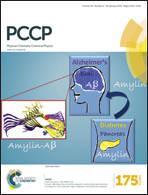Flexibility at a glycosidic linkage revealed by molecular dynamics, stochastic modeling, and 13C NMR spin relaxation: conformational preferences of α-l-Rhap-α-(1 → 2)-α-l-Rhap-OMe in water and dimethyl sulfoxide solutions
Abstract
The monosaccharide L-rhamnose is common in bacterial polysaccharides and the disaccharide α-L-Rhap-α-(1 → 2)-α-L-Rhap-OMe represents a structural model for a part of Shigella flexneri O-antigen polysaccharides. Utilization of [1′-13C]-site-specific labeling in the anomeric position at the glycosidic linkage between the two sugar residues facilitated the determination of transglycosidic NMR 3JCH and 3JCC coupling constants. Based on these spin–spin couplings the major state and the conformational distribution could be determined with respect to the ψ torsion angle, which changed between water and dimethyl sulfoxide (DMSO) as solvents, a finding mirrored by molecular dynamics (MD) simulations with explicit solvent molecules. The 13C NMR spin relaxation parameters T1, T2, and heteronuclear NOE of the probe were measured for the disaccharide in DMSO-d6 at two magnetic field strengths, with standard deviations ≤1%. The combination of MD simulation and a stochastic description based on the diffusive chain model resulted in excellent agreement between calculated and experimentally observed 13C relaxation parameters, with an average error of <2%. The coupling between the global reorientation of the molecule and the local motion of the spin probe is deemed essential if reproduction of NMR relaxation parameters should succeed, since decoupling of the two modes of motion results in significantly worse agreement. Calculation of 13C relaxation parameters based on the correlation functions obtained directly from the MD simulation of the solute molecule in DMSO as solvent showed satisfactory agreement with errors on the order of 10% or less.


 Please wait while we load your content...
Please wait while we load your content...